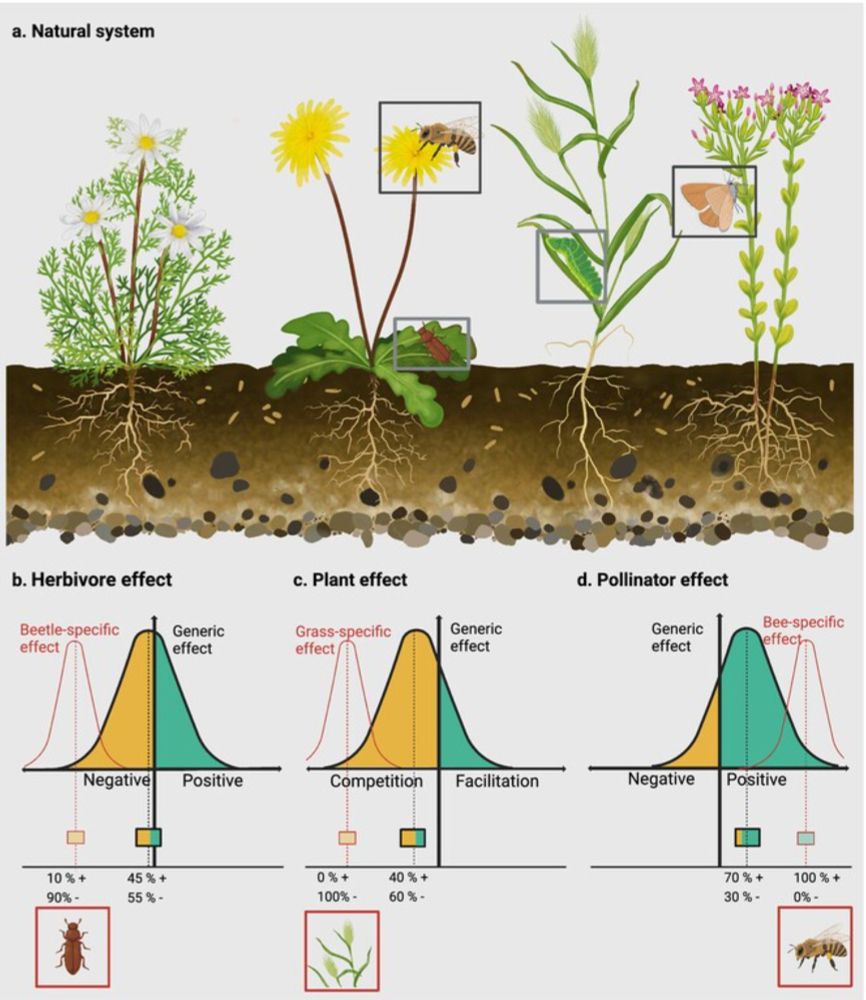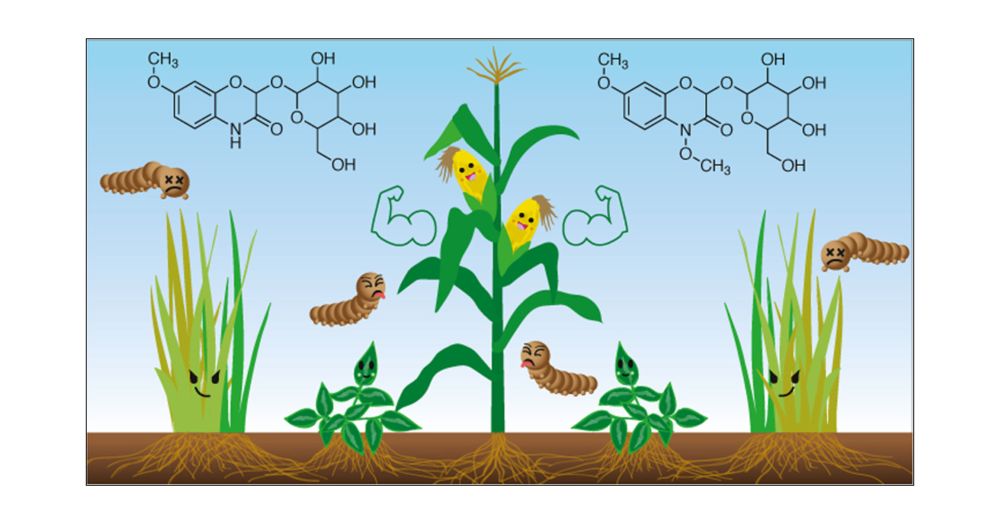Yet, dishonest plants persist in the population. How they are maintained despite strong bee preference for honesty remains a mystery!
24.03.2025 22:50 — 👍 1 🔁 0 💬 0 📌 0Sergio E. Ramos
@sergioeramos.bsky.social
@sergioeramos.bsky.social
Yet, dishonest plants persist in the population. How they are maintained despite strong bee preference for honesty remains a mystery!
24.03.2025 22:50 — 👍 1 🔁 0 💬 0 📌 0🧬 Here, we show that the degree of plant honesty is partly heritable. Since bees favor honest plants, they can drive the evolution of honesty—leading to higher seed production in honest plants.
24.03.2025 22:50 — 👍 1 🔁 0 💬 1 📌 0🌸 An honest plant exhibits a positive correlation between its signal and reward, allowing bees to learn this association and prefer honest plants over dishonest ones.
24.03.2025 22:50 — 👍 1 🔁 0 💬 1 📌 0🐝 Bees searching for flowers cannot directly see how much nectar (i.e., reward) a flower contains. Instead, they rely on honest floral signals, such as flower size or scent.
24.03.2025 22:50 — 👍 1 🔁 0 💬 1 📌 0News Release from @EurekAlert: www.eurekalert.org/news-release...
24.03.2025 22:32 — 👍 0 🔁 0 💬 0 📌 0 24.03.2025 22:28 — 👍 1 🔁 0 💬 1 📌 0
24.03.2025 22:28 — 👍 1 🔁 0 💬 1 📌 0
Super excited about my latest paper published in one of my favorite journals @newphyt.bsky.social
🌸🐝 Plant honesty to their pollinators is partly heritable; bees prefer honest plants and these produce more seeds.
Then why are there dishonest genotypes? 🤔 that's the next question!
Link below

Four-part photo of Turnera velutina flowers showing manually stained anthers using different natural pigments (A) Micropipette with the natural pigment before staining the anthers, (B) Safranin, (C) Methylene blue, (D) Fast green. The use of different colors allowed distinguishing pollen movement within and between flowers. This procedure was applied to each experimental trial to estimate the efficiency of cross-pollination and how this depends or not on the phenotype of neighboring plants.
Effects of anther-stigma position on cross-#pollination efficiency in a # hermaphroditic plant
New #AJB research by Matias Baranzelli, Manuel Ochoa-Sánchez, Sergio Ramos, Fernanda Baena-Díaz, Paula Sosenski, Karina Boege, Cesar Domínguez & Juan Fornoni
doi.org/10.1002/ajb2... #botany

Yayy 🌱🪲🐝🐌- A list of stellar ecologists and myself showed that (1) species interactions can be summarised at the guild level, except for a few critical species, (2) they occur along a continuum from positive-to-negative, and (3) they have relatively weak strength except between plants!
31.01.2025 05:51 — 👍 40 🔁 17 💬 2 📌 0Congrats! I'm so looking forward to reading this paper 🤩
05.02.2025 20:24 — 👍 1 🔁 0 💬 0 📌 0
Van Valen's Red Queen Hypothesis says that species within ecosystems must constantly change (as in Alice in Wonderland, my drawing) to remain in place. This classic paper was rejected multiple times, and the author created a new journal to publish it mn.uio.no/cees/english...
29.01.2025 23:16 — 👍 50 🔁 13 💬 5 📌 1This is a great initiative. I wonder if it has anything to do with the plant-pollinator interaction networks collected by the collective efforts of lots of people during Covid times. As far as I recall, that was coordinated by @jeffollerton.bsky.social
05.02.2025 19:57 — 👍 0 🔁 0 💬 1 📌 0
[new paper] EuPPollNet: A European Database of Plant-Pollinator Networks
onlinelibrary.wiley.com/doi/10.1111/... Another wonderful paper of @joseblanuza.bsky.social making open more than >1500 networks and looking at their properties. Come for the data, stay for the cool figures!

📄 Check out the full paper, free for 50 days! www.sciencedirect.com/science/arti...
21.11.2024 21:14 — 👍 3 🔁 3 💬 1 📌 0We show that plant reproduction can be highly plastic at different stages of the process and spatiotemporal scales, affecting plant ecology and evolution, and that in crops 🌾 such plasticity can be beneficial or detrimental.
21.11.2024 21:14 — 👍 1 🔁 0 💬 1 📌 0Together with Hanneke Suijkerbuijk and Erik H. Poelman, we have compiled the existing literature and reviewed this important and timely topic.
21.11.2024 21:14 — 👍 1 🔁 0 💬 1 📌 0Although we know that plants 🌿 can be highly plastic and adjust to real-time changes in their environment, there has been no discussion about how plastic are plants in their reproduction.
21.11.2024 21:14 — 👍 1 🔁 0 💬 1 📌 0Plant reproduction is therefore a crucial process that provides us with food and allows plants to continue to exist and adapt to their ever-changing environment.
21.11.2024 21:14 — 👍 1 🔁 0 💬 1 📌 0A fruit is a fertilized ovary 🍎, seeds like almonds are fertilized ovules (and by the way, almonds need 100% pollination by bees).
21.11.2024 21:14 — 👍 1 🔁 0 💬 1 📌 0
Paper alert 📄🚨 Plasticity in Plant Mating Systems
@Trends in Plant Science
Most of the seeds, fruits and vegetables we enjoy are the result of plant reproduction 🌸 🌻 🐝.
Is there a similar effort for the evolution/evolutionary biologists community? thanks
21.11.2024 20:59 — 👍 0 🔁 0 💬 0 📌 0
New paper from our group! We found that maize plants from push-push fields had a higher relative abundance of metabolites toxic to insect herbivores. This suggests that maize plants growing with companion plants are "stronger" than maize plants growing alone.
pubs.acs.org/doi/10.1021/...
Hello Science Bluesky! We just moved here from the other page and are looking forward to engaging with everyone here. We are the Spatial Genetics lab at the University of Zurich and work on plant ecological chemistry, genomics, remote sensing, biodiversity and much more! 🍂🌱🪴🌳🛩️🌍🛰️
16.11.2023 13:12 — 👍 16 🔁 2 💬 0 📌 22 open PhD positions about unravelling plant-insect communication for sustainable agroecosystems in Switzerland! informationecology.github.io/openpositions/
11.11.2024 13:58 — 👍 14 🔁 12 💬 1 📌 1